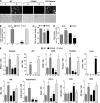Protein phosphatase 5 mediates lipid metabolism through reciprocal control of glucocorticoid receptor and peroxisome proliferator-activated receptor-γ (PPARγ)
- PMID: 21994940
- PMCID: PMC3234872
- DOI: 10.1074/jbc.M111.311662
Protein phosphatase 5 mediates lipid metabolism through reciprocal control of glucocorticoid receptor and peroxisome proliferator-activated receptor-γ (PPARγ)
Abstract
Glucocorticoid receptor-α (GRα) and peroxisome proliferator-activated receptor-γ (PPARγ) regulate adipogenesis by controlling the balance between lipolysis and lipogenesis. Here, we show that protein phosphatase 5 (PP5), a nuclear receptor co-chaperone, reciprocally modulates the lipometabolic activities of GRα and PPARγ. Wild-type and PP5-deficient (KO) mouse embryonic fibroblast cells were used to show binding of PP5 to both GRα and PPARγ. In response to adipogenic stimuli, PP5-KO mouse embryonic fibroblast cells showed almost no lipid accumulation with reduced expression of adipogenic markers (aP2, CD36, and perilipin) and low fatty-acid synthase enzymatic activity. This was completely reversed following reintroduction of PP5. Loss of PP5 increased phosphorylation of GRα at serines 212 and 234 and elevated dexamethasone-induced activity at prolipolytic genes. In contrast, PPARγ in PP5-KO cells was hyperphosphorylated at serine 112 but had reduced rosiglitazone-induced activity at lipogenic genes. Expression of the S112A mutant rescued PPARγ transcriptional activity and lipid accumulation in PP5-KO cells pointing to Ser-112 as an important residue of PP5 action. This work identifies PP5 as a fulcrum point in nuclear receptor control of the lipolysis/lipogenesis equilibrium and as a potential target in the treatment of obesity.
Figures







Similar articles
-
FKBP51 controls cellular adipogenesis through p38 kinase-mediated phosphorylation of GRα and PPARγ.Mol Endocrinol. 2014 Aug;28(8):1265-75. doi: 10.1210/me.2014-1022. Epub 2014 Jun 16. Mol Endocrinol. 2014. PMID: 24933247 Free PMC article.
-
Protein Phosphatase PP5 Controls Bone Mass and the Negative Effects of Rosiglitazone on Bone through Reciprocal Regulation of PPARγ (Peroxisome Proliferator-activated Receptor γ) and RUNX2 (Runt-related Transcription Factor 2).J Biol Chem. 2016 Nov 18;291(47):24475-24486. doi: 10.1074/jbc.M116.752493. Epub 2016 Sep 29. J Biol Chem. 2016. Retraction in: J Biol Chem. 2018 May 25;293(21):8314. doi: 10.1074/jbc.W118.003815. PMID: 27687725 Free PMC article. Retracted.
-
FKBP51 reciprocally regulates GRα and PPARγ activation via the Akt-p38 pathway.Mol Endocrinol. 2014 Aug;28(8):1254-64. doi: 10.1210/me.2014-1023. Epub 2014 Jun 16. Mol Endocrinol. 2014. PMID: 24933248 Free PMC article.
-
Protein phosphatase 5.Int J Biochem Cell Biol. 2008;40(11):2358-62. doi: 10.1016/j.biocel.2007.08.010. Epub 2007 Aug 30. Int J Biochem Cell Biol. 2008. PMID: 17951098 Free PMC article. Review.
-
The glucocorticoid receptor: cause of or cure for obesity?Am J Physiol Endocrinol Metab. 2016 Feb 15;310(4):E249-57. doi: 10.1152/ajpendo.00478.2015. Epub 2015 Dec 29. Am J Physiol Endocrinol Metab. 2016. PMID: 26714851 Free PMC article. Review.
Cited by
-
Serine/threonine protein phosphatase 5 regulates glucose homeostasis in vivo and apoptosis signalling in mouse pancreatic islets and clonal MIN6 cells.Diabetologia. 2012 Jul;55(7):2005-15. doi: 10.1007/s00125-012-2541-1. Epub 2012 Apr 12. Diabetologia. 2012. PMID: 22526606
-
WIP1 phosphatase is a critical regulator of adipogenesis through dephosphorylating PPARγ serine 112.Cell Mol Life Sci. 2017 Jun;74(11):2067-2079. doi: 10.1007/s00018-016-2450-4. Epub 2017 Feb 8. Cell Mol Life Sci. 2017. PMID: 28180926 Free PMC article.
-
The Role of Transcription Factor PPAR-γ in the Pathogenesis of Psoriasis, Skin Cells, and Immune Cells.Int J Mol Sci. 2022 Aug 26;23(17):9708. doi: 10.3390/ijms23179708. Int J Mol Sci. 2022. PMID: 36077103 Free PMC article. Review.
-
Partial agonist, telmisartan, maintains PPARγ serine 112 phosphorylation, and does not affect osteoblast differentiation and bone mass.PLoS One. 2014 May 8;9(5):e96323. doi: 10.1371/journal.pone.0096323. eCollection 2014. PLoS One. 2014. PMID: 24810249 Free PMC article.
-
Heterozygous De Novo UBTF Gain-of-Function Variant Is Associated with Neurodegeneration in Childhood.Am J Hum Genet. 2017 Aug 3;101(2):267-273. doi: 10.1016/j.ajhg.2017.07.002. Am J Hum Genet. 2017. PMID: 28777933 Free PMC article.
References
Publication types
MeSH terms
Substances
Grants and funding
LinkOut - more resources
Full Text Sources
Molecular Biology Databases
Research Materials

